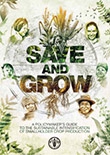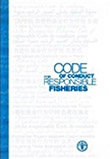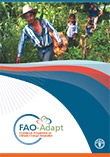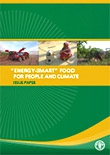Publications

In 2011, FAO launched Save and Grow as a new paradigm for intensive crop production for that would enhance both productivity and sustainability. Save and Grow calls for greening of the Green Revolution through an ecosystem approach that draws on nature's contribution to crop growth, such as organic matter, water flow regulation, pollination and bio-control of insect pests and diseases.

This special edition of the Code of Conduct for Responsible Fisheries commemorates 15 years since the Code was unanimously adopted on 31 October 1995. It includes the text of the Code in its entirety, background to the origin and elaboration of the Code and Resolution 4/95 as adopted by the Twenty-eighth session of the Conference of the Food and Agriculture Organization of the United Nations (FAO). It also contains a CD-ROM containing the Code, its supporting documents and instruments, technical guidelines and related information.

This document is the outcome of a collaborative effort across FAO involving headquarters, technical departments and regional, subregional and liaison offices. It was coordinated by the adaptation subgroup of FAO's Inter-Departmental Working Group on Climate Change (IDWG-CC). We sincerely wish to thank all FAO colleagues involved for their commitment, technical contributions and stimulating debates. In particular, we would like to thank the departmental and regional focal points for climate change for the coordination within their respective units, Kaisa Karttunen for the technical consolidation of the document, and the co-chairs of the adaptation subgroup, Stephan Baas and Doris Soto, who facilitated the participatory dialogue for the development of FAO-Adapt throughout FAO.

The aim of this paper is to discuss how the entire food sector, from the farmer's field to the consumer's plate, can become more "energy-smart". Becoming energy-smart will require a transformation along the food chain that involves: - relying more on low-carbon energy systems and using energy more efficiently; - strengthening the role of renewable energy within food systems; - providing greater access to modern energy services for development, and at the same time supporting the achievement of national food security and sustainable development goals. This paper provides examples of energy-smart practices for both small-and large-scale enterprises and covers the entire food sector.

Le Conseil de la FAO a adopté le Deuxième Plan d’action mondial pour les ressources phytogénétiques pour l’alimentation et l’agriculture lors de sa 143 ème session en 2011. Il s’agit de la mise à jour du Plan d’action mondial pour la conservation et l’utilisation durable des ressources phytogénétiques qui avait été adopté à la quatrième Conférence technique internationale sur les ressources phytogénétiques organisée à Leipzig en 1996.
Le Deuxième Plan d’action mondial répond à de nouveaux défis, tels que le changement climatique et l’insécurité alimentaire, ainsi qu’à de nouvelles opportunités, notamment les méthodologies d’information, de communication et de biologie moléculaire. Il contient 18 activités prioritaires classées en quatre grands groupes: Conservation et gestion in situ; Conservation ex situ; Utilisation durable; et Renforcement durable des capacités institutionnelles et humaines.

